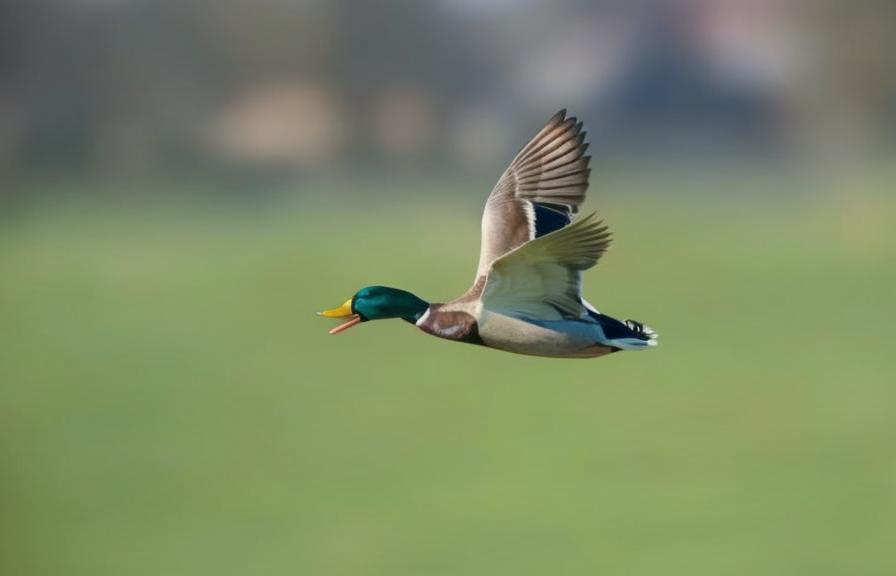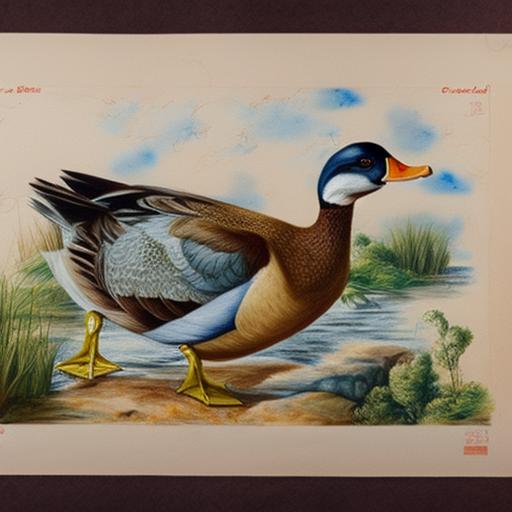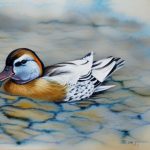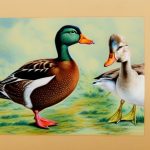Ducks have been domesticated for thousands of years, and they are not only valued for their eggs and feathers but also for their meat. In recent years, there has been a growing interest in raising ducks specifically for meat production. Meat duck breeds are specifically bred and raised for their high-quality meat, which is known for its rich flavor and tender texture. These breeds are carefully selected and bred to maximize their meat production potential, making them a popular choice for farmers and homesteaders looking to raise their own meat. In this article, we will explore the popular meat duck breeds, their characteristics, considerations for raising them, breeding and reproduction, as well as management and care.
Key Takeaways
- Meat duck breeds are specifically bred for their high meat production and are popular among farmers for their efficiency and quality of meat.
- Popular meat duck breeds for meat production include the Pekin, Muscovy, and Moulard ducks, each with their own unique characteristics and advantages.
- Meat duck breeds are known for their fast growth, high feed conversion rates, and ability to thrive in various environmental conditions, making them a desirable choice for meat production.
- When raising meat ducks, considerations such as housing, feeding, and disease prevention are important factors to ensure the health and well-being of the ducks and the quality of the meat produced.
- Breeding and reproduction of meat ducks require careful management and selection of breeding stock to maintain and improve desirable traits in meat production. Proper care and management practices are essential for the overall health and well-being of meat duck breeds.
Popular Breeds for Meat Production
There are several popular meat duck breeds that are known for their excellent meat production qualities. One of the most popular breeds is the Pekin duck, which is known for its fast growth rate and high meat yield. Pekin ducks have a white plumage and a yellow bill, and they are known for their calm and friendly disposition, making them easy to handle and raise. Another popular meat duck breed is the Muscovy duck, which is known for its lean and flavorful meat. Muscovy ducks have a distinct appearance with red wattles around their bill and a unique quack-less voice. They are also known for their excellent foraging abilities, making them well-suited for free-range systems. Other popular meat duck breeds include the Khaki Campbell, Rouen, and Aylesbury, each with its own unique characteristics and meat production qualities.
Pekin ducks are known for their rapid growth and high feed conversion ratio, making them an efficient choice for meat production. Muscovy ducks, on the other hand, are valued for their lean and flavorful meat, as well as their ability to forage for a portion of their diet. Khaki Campbell ducks are known for their high egg production as well as their meat quality, making them a dual-purpose breed. Rouen ducks are prized for their large size and excellent meat yield, while Aylesbury ducks are known for their tender and succulent meat. Each of these breeds has its own unique qualities that make them well-suited for meat production, and farmers can choose the breed that best fits their specific needs and preferences.
Characteristics of Meat Duck Breeds
Meat duck breeds are specifically selected and bred for their meat production qualities, which include rapid growth, high meat yield, and excellent meat quality. These breeds are typically larger in size compared to egg-laying breeds, with a plump body and well-developed muscles. They also have a higher feed conversion ratio, meaning they can efficiently convert feed into meat. Meat duck breeds may have different growth rates, with some reaching market weight in as little as 7-9 weeks, while others may take 12-14 weeks. The meat of these breeds is known for its rich flavor, tender texture, and low fat content, making it a popular choice for culinary purposes.
In addition to their meat production qualities, meat duck breeds may also have specific traits that make them well-suited for different production systems. For example, some breeds may be more adaptable to free-range systems and have excellent foraging abilities, while others may thrive in more confined spaces. The temperament of the breed is also an important consideration, as some breeds may be more docile and easy to handle, while others may be more active and independent. Understanding the specific characteristics of each meat duck breed is important for farmers to make informed decisions about which breed is best suited for their production goals and management practices.
Considerations for Raising Meat Ducks
Raising meat ducks requires careful consideration of several factors to ensure the health and well-being of the birds as well as the success of the meat production enterprise. One important consideration is housing and space requirements. Meat ducks need adequate space to move around and exercise, as well as protection from predators and the elements. The housing should also provide good ventilation and be easy to clean to maintain a healthy environment for the ducks. Another consideration is nutrition and feeding. Meat ducks require a balanced diet that meets their nutritional needs for rapid growth and muscle development. Farmers should provide a high-quality commercial feed or formulate a custom feed ration that meets the specific requirements of meat duck breeds.
Health management is also an important consideration when raising meat ducks. Farmers should implement a vaccination program and regular health checks to prevent common diseases and parasites that can affect the ducks’ growth and overall health. Good biosecurity practices should also be in place to prevent the introduction and spread of diseases within the flock. Additionally, proper handling and transportation practices should be followed to minimize stress on the ducks, especially during the marketing process. By carefully considering these factors, farmers can ensure the successful raising of meat ducks for high-quality meat production.
Breeding and Reproduction of Meat Ducks
Breeding and reproduction are essential aspects of raising meat ducks for sustainable meat production. Selecting breeding stock with desirable traits such as rapid growth, high meat yield, and good conformation is crucial to producing offspring with excellent meat production qualities. Farmers should carefully evaluate the breeding stock based on these traits and select individuals that meet the desired standards. Controlled mating practices should be implemented to ensure genetic diversity and prevent inbreeding within the flock.
Proper management of breeding ducks is also important to ensure successful reproduction. Providing a suitable nesting environment with clean bedding materials and adequate nesting boxes will encourage natural mating behavior and egg laying. Farmers should also monitor the fertility and hatchability of eggs to assess the reproductive performance of the breeding ducks. Incubation of eggs can be done using natural brooding methods or artificial incubation equipment to hatch healthy ducklings.
Managing the reproductive cycle of meat ducks is essential to maintain a consistent supply of ducklings for meat production. By implementing proper breeding and reproduction practices, farmers can ensure the genetic quality and productivity of their meat duck flock for sustainable meat production.
Management and Care of Meat Duck Breeds

Proper management and care are essential for the health and well-being of meat duck breeds throughout their life cycle. Providing a suitable environment with access to clean water, adequate space, and protection from predators is crucial for the overall welfare of the ducks. Farmers should also implement good biosecurity practices to prevent the introduction and spread of diseases within the flock.
Nutrition management is another important aspect of caring for meat duck breeds. Ducks should be provided with a balanced diet that meets their nutritional requirements for rapid growth and muscle development. Farmers can use commercial feed or formulate a custom feed ration based on the specific needs of meat duck breeds. Access to fresh pasture or forage can also supplement the ducks’ diet and provide additional nutrients.
Health management is crucial for preventing common diseases and parasites that can affect the growth and productivity of meat duck breeds. Farmers should implement a vaccination program, regular health checks, and proper sanitation practices to maintain a healthy flock. Monitoring the ducks’ behavior, growth rate, and overall condition can help identify any health issues early on and take appropriate measures to address them.
Handling and transportation practices should also be considered when managing meat duck breeds. Ducks should be handled gently to minimize stress, especially during activities such as catching, loading, and transportation. Providing a calm and low-stress environment can help ensure the welfare of the ducks throughout their life cycle.
Conclusion and Future Trends in Meat Duck Breeding
In conclusion, meat duck breeds are specifically bred and raised for their high-quality meat production qualities, making them a popular choice for farmers looking to raise their own meat. Understanding the characteristics of popular meat duck breeds, considerations for raising them, breeding and reproduction practices, as well as management and care is essential for successful meat production.
In the future, there may be continued interest in developing new meat duck breeds with improved growth rates, feed efficiency, and meat quality. Sustainable production practices such as free-range systems and organic production may also become more prevalent as consumers seek high-quality and ethically produced duck meat. Additionally, advancements in genetics, nutrition, and health management may further enhance the productivity and welfare of meat duck breeds.
Overall, the future trends in meat duck breeding are likely to focus on improving efficiency, sustainability, and animal welfare to meet the growing demand for high-quality duck meat in the global market. By staying informed about these trends and implementing best practices in meat duck breeding, farmers can contribute to the continued success of this important sector in poultry production.
If you’re interested in learning more about raising ducks for meat, you might also want to check out Poultry Wizard’s article on how many chickens you need for a family of 4. Understanding the dynamics of poultry farming and the different breeds suitable for meat production can be beneficial for anyone looking to start their own small-scale farm or homestead.
FAQs
What are meat duck breeds?
Meat duck breeds are specifically bred for their meat production. These breeds are selected and raised for their ability to grow quickly and produce high-quality meat.
What are some popular meat duck breeds?
Some popular meat duck breeds include the Pekin, Muscovy, and the Moulard. These breeds are known for their fast growth and high meat yield.
What are the characteristics of meat duck breeds?
Meat duck breeds are typically larger in size compared to other duck breeds. They have a high meat-to-bone ratio and are known for their tender and flavorful meat.
How are meat duck breeds raised?
Meat duck breeds are often raised in a free-range or semi-intensive system. They require access to water for swimming and foraging, as well as a balanced diet to support their rapid growth.
What are the advantages of raising meat duck breeds?
Raising meat duck breeds can be advantageous for farmers and producers due to their fast growth rate, high meat yield, and adaptability to various farming systems. Additionally, duck meat is considered a delicacy in many cuisines, making it a valuable product for the market.
Meet Walter, the feathered-friend fanatic of Florida! Nestled in the sunshine state, Walter struts through life with his feathered companions, clucking his way to happiness. With a coop that’s fancier than a five-star hotel, he’s the Don Juan of the chicken world. When he’s not teaching his hens to do the cha-cha, you’ll find him in a heated debate with his prized rooster, Sir Clucks-a-Lot. Walter’s poultry passion is no yolk; he’s the sunny-side-up guy you never knew you needed in your flock of friends!







